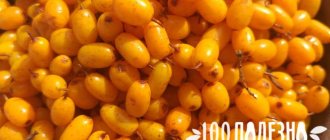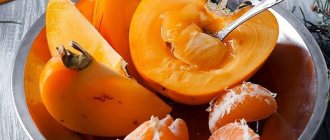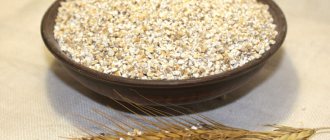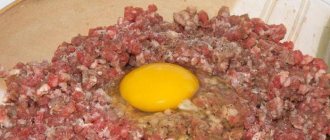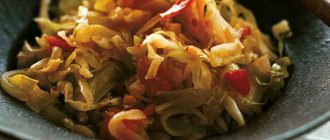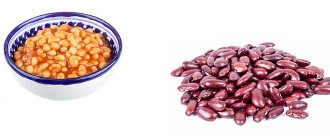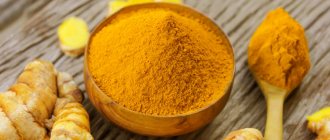The exotic feijoa berry appeared on the Russian market relatively recently. And when it comes to its special taste, then the legend comes to mind. The young man fell in love with the sea princess and settled with her in the underwater kingdom, but he really missed the sun and sky. One day he decided to rise to earth and the underwater king, angry, turned him into a tree with fruits that tasted like the sea breeze. They are not only fragrant. Nutritionists and doctors agree that feijoa berries have many beneficial properties for the body.
How is feijoa useful for weight loss?
You can find a recommendation to consume only 2 fruits per day to cover iodine deficiency. But you can, of course, eat more. The American Dietetic Association recommends servings of fruits and berries of 100-120 g, and eating 2-3 such servings depending on weight and physical activity. Due to the high iodine content, the berry helps maintain metabolic rate, therefore helping to lose weight faster.
There is no mono-diet for feijoa, since the fruits are quite poorly distributed. But this is for the better - it is always useful to eat a balanced diet and get all the necessary substances from food.
The composition allows you to include this product in a diet recommended for certain diseases, weakened immunity and the desire to reduce weight. It is recommended for a low-calorie diet in an amount of approximately 400 g per day. Those who like to experiment are encouraged to replace dinner with green berries (about 300 g).
If the decision to go on a diet seems too bold to you for now, you can start by replacing your usual sweet foods with a few berries.
Feijoa calories. Chemical composition and nutritional value.
Nutritional value and chemical composition of Feijoa.
The table shows the nutritional content (calories, proteins, fats, carbohydrates, vitamins and minerals) per 100 grams of edible portion.
| Nutrient | Quantity | Norm** | % of the norm in 100 g | % of the norm in 100 kcal | 100% normal |
| Calorie content | 61 kcal | 1684 kcal | 3.6% | 5.9% | 2761 g |
| Squirrels | 0.71 g | 76 g | 0.9% | 1.5% | 10704 g |
| Fats | 0.42 g | 56 g | 0.8% | 1.3% | 13333 g |
| Carbohydrates | 8.81 g | 219 g | 4% | 6.6% | 2486 g |
| Alimentary fiber | 6.4 g | 20 g | 32% | 52.5% | 313 g |
| Water | 83.28 g | 2273 g | 3.7% | 6.1% | 2729 g |
| Ash | 0.38 g | ~ | |||
| Vitamins | |||||
| beta carotene | 0.002 mg | 5 mg | 250000 g | ||
| beta Cryptoxanthin | 3 mcg | ~ | |||
| Lycopene | 5 mcg | ~ | |||
| Lutein + Zeaxanthin | 27 mcg | ~ | |||
| Vitamin B1, thiamine | 0.006 mg | 1.5 mg | 0.4% | 0.7% | 25000 g |
| Vitamin B2, riboflavin | 0.018 mg | 1.8 mg | 1% | 1.6% | 10000 g |
| Vitamin B5, pantothenic | 0.233 mg | 5 mg | 4.7% | 7.7% | 2146 g |
| Vitamin B6, pyridoxine | 0.067 mg | 2 mg | 3.4% | 5.6% | 2985 g |
| Vitamin B9, folates | 23 mcg | 400 mcg | 5.8% | 9.5% | 1739 |
| Vitamin C, ascorbic acid | 32.9 mg | 90 mg | 36.6% | 60% | 274 g |
| Vitamin E, alpha tocopherol, TE | 0.16 mg | 15 mg | 1.1% | 1.8% | 9375 g |
| gamma tocopherol | 0.03 mg | ~ | |||
| Vitamin H, biotin | 0.4 mcg | 50 mcg | 0.8% | 1.3% | 12500 g |
| Vitamin K, phylloquinone | 3.5 mcg | 120 mcg | 2.9% | 4.8% | 3429 g |
| Vitamin RR, NE | 0.295 mg | 20 mg | 1.5% | 2.5% | 6780 g |
| Macronutrients | |||||
| Potassium, K | 172 mg | 2500 mg | 6.9% | 11.3% | 1453 g |
| Calcium, Ca | 17 mg | 1000 mg | 1.7% | 2.8% | 5882 g |
| Silicon, Si | 13 mg | 30 mg | 43.3% | 71% | 231 g |
| Magnesium, Mg | 9 mg | 400 mg | 2.3% | 3.8% | 4444 g |
| Sodium, Na | 3 mg | 1300 mg | 0.2% | 0.3% | 43333 g |
| Sera, S | 5 mg | 1000 mg | 0.5% | 0.8% | 20000 g |
| Phosphorus, P | 19 mg | 800 mg | 2.4% | 3.9% | 4211 g |
| Chlorine, Cl | 8 mg | 2300 mg | 0.3% | 0.5% | 28750 g |
| Microelements | |||||
| Aluminium, Al | 384.4 mcg | ~ | |||
| Bor, B | 32.9 mcg | ~ | |||
| Vanadium, V | 2 mcg | ~ | |||
| Iron, Fe | 0.14 mg | 18 mg | 0.8% | 1.3% | 12857 g |
| Yod, I | 20 mcg | 150 mcg | 13.3% | 21.8% | 750 g |
| Cobalt, Co | 1.4 mcg | 10 mcg | 14% | 23% | 714 g |
| Lithium, Li | 5 mcg | ~ | |||
| Manganese, Mn | 0.084 mg | 2 mg | 4.2% | 6.9% | 2381 g |
| Copper, Cu | 36 mcg | 1000 mcg | 3.6% | 5.9% | 2778 g |
| Molybdenum, Mo | 6 mcg | 70 mcg | 8.6% | 14.1% | 1167 g |
| Nickel, Ni | 6 mcg | ~ | |||
| Rubidium, Rb | 10 mcg | ~ | |||
| Selenium, Se | 1.8 mcg | 55 mcg | 3.3% | 5.4% | 3056 g |
| Strontium, Sr | 16 mcg | ~ | |||
| Fluorine, F | 30 mcg | 4000 mcg | 0.8% | 1.3% | 13333 g |
| Chromium, Cr | 7 mcg | 50 mcg | 14% | 23% | 714 g |
| Zinc, Zn | 0.06 mg | 12 mg | 0.5% | 0.8% | 20000 g |
| Zirconium, Zr | 10 mcg | ~ | |||
| Digestible carbohydrates | |||||
| Mono- and disaccharides (sugars) | 8.2 g | max 100 g | |||
| Glucose (dextrose) | 2.32 g | ~ | |||
| Sucrose | 2.93 g | ~ | |||
| Fructose | 2.95 g | ~ | |||
| Essential amino acids | |||||
| Arginine* | 0.019 g | ~ | |||
| Valin | 0.019 g | ~ | |||
| Histidine* | 0.009 g | ~ | |||
| Isoleucine | 0.019 g | ~ | |||
| Leucine | 0.028 g | ~ | |||
| Lysine | 0.038 g | ~ | |||
| Methionine | 0.007 g | ~ | |||
| Threonine | 0.019 g | ~ | |||
| Tryptophan | 0.007 g | ~ | |||
| Phenylalanine | 0.019 g | ~ | |||
| Nonessential amino acids | |||||
| Alanin | 0.038 g | ~ | |||
| Aspartic acid | 0.075 g | ~ | |||
| Glycine | 0.028 g | ~ | |||
| Glutamic acid | 0.132 g | ~ | |||
| Proline | 0.019 g | ~ | |||
| Serin | 0.028 g | ~ | |||
| Tyrosine | 0.009 g | ~ | |||
| Cysteine | 0.007 g | ~ | |||
| Saturated fatty acids | |||||
| Saturated fatty acids | 0.104 g | max 18.7 g | |||
| 4:0 Oil | 0.004 g | ~ | |||
| 10:0 Kaprinovaya | 0.003 g | ~ | |||
| 12:0 Lauric | 0.001 g | ~ | |||
| 14:0 Miristinovaya | 0.003 g | ~ | |||
| 16:0 Palmitinaya | 0.075 g | ~ | |||
| 18:0 Stearic | 0.014 g | ~ | |||
| 20:0 Arakhinovaya | 0.003 g | ~ | |||
| Monounsaturated fatty acids | 0.056 g | min 16.8 g | 0.3% | 0.5% | |
| 18:1 Oleic (omega-9) | 0.056 g | ~ | |||
| 18:1 cis | 0.056 g | ~ | |||
| Polyunsaturated fatty acids | 0.136 g | from 11.2 to 20.6 g | 1.2% | 2% | |
| 18:2 Linolevaya | 0.107 g | ~ | |||
| 18:2 Omega-6, cis, cis | 0.107 g | ~ | |||
| 18:3 Linolenic | 0.029 g | ~ | |||
| 18:3 Omega-3, alpha-linolenic | 0.029 g | ~ | |||
| Omega-3 fatty acids | 0.029 g | from 0.9 to 3.7 g | 3.2% | 5.2% | |
| Omega-6 fatty acids | 0.107 g | from 4.7 to 16.8 g | 2.3% | 3.8% |
The energy value of Feijoa is 61 kcal.
- fruit without refuse = 50 g (30.5 kcal)
- cup, pureed = 243 g (148.2 kcal)
Primary source: USDA National Nutrient Database for Standard Reference. Read more.
** This table shows the average levels of vitamins and minerals for an adult. If you want to know the norms taking into account your gender, age and other factors, then use the “My Healthy Diet” application.
Feijoa in the diet of pregnant women, nursing mothers, children, diabetics: recommendations from nutritionists
Feijoa can be included in a pregnant woman's diet , except in cases where the expectant mother is allergic. The fruits are rich in folates, and contribute to the proper formation of the fetal circulatory system. Additional iodine infusions from plant sources also help maintain the health of the hormonal system. And the di-heme iron in the composition helps protect against iron deficiency anemia, which occurs during pregnancy.
The fruit should be consumed with caution by those with gestational diabetes . In this case, doctors recommend doing a blood sugar test after eating foods, and selecting a diet individually.
The issue with nursing mothers is not straightforward. There are recommendations to exclude everything from the diet except green apples during breastfeeding. This is a hypoallergenic diet, but it should not be followed by everyone. The answer to the question depends on whether the child has an allergy or not.
The fruits contain only 10 g of carbohydrates per 100 g, and a lot of fiber. They can be used for diabetes , you just need to take into account the total amount of carbohydrates in the diet. Sometimes it is recommended to choose unsweetened varieties of feijoa.
For athletes, the fruit has great benefits. First of all, it promotes recovery after intense exercise, as it has a beneficial effect on hematopoiesis. This is the quality of all iron sources. In addition, the fruits are rich in antioxidants, which helps get rid of inflammatory processes in joints and tissues due to overload.
Reviews
I consumed one feijoa fruit for a month, which helped a lot with iodine deficiency, I didn’t even have to take pharmacological drugs.
Alexander, Tula.
When I was on a fruit diet, I bought feijoa to diversify my diet. It is very easy to eat, just cut it in half and scrape out the pulp with a spoon.
Angela, Moscow.
The doctor advised to include feijoa in the menu, as it contains a lot of vitamins and microelements. I didn’t really like the taste of the fresh fruit, it was reminiscent of strawberries and kiwi, but I also felt the aroma of juniper, which is not very appetizing. But then I found a very interesting recipe: the “butts” are cut off from the berries, cut into circles and poured with liquid honey. After just 10 minutes the fruit softens and becomes very tasty.
Lyudmila Ivanovna, Tomsk.
I really liked these tropical fruits, I’ve been buying them since they were brought to our supermarkets. It comes in handy when you want fruit, but are tired of all sorts of apples and oranges.
Pavel, Krasnoyarsk.
How to use

It is a versatile fruit used to make desserts, yoghurts, sauces, jams, jellies, cakes, juices or marmalades. The pleasant smell of fresh fruits will improve the taste of fruit salads. They are also added to puddings and pastry fillings.
Sweet feijoa fruits are a healthy alternative to sweet desserts. The fruits are eaten fresh, cut in half: the pulp is scooped out with a small spoon, leaving the skin. One of the advantages of these fruits is that they can be frozen without losing flavor, aroma, color or texture. This fruit is added to chocolate, tea, cereals, wine, vodka, gin, alcoholic and non-alcoholic cocktails, and ripe fruits are preserved.
Its extract is included in cosmetics, and the seeds are used as a natural scrub. Masks made from pulp lighten and rejuvenate the skin, and make the hair shiny and healthy. In alternative medicine, feijoa is known as a remedy for colds, fever, hypertension and unstable blood pressure. This fruit is recommended for people struggling with cancer. And gardeners love to grow feijoas as hedges, which can last more than 45 years.
Dish recipes
The fruits are often used to prepare unusual dishes. Feijoa goes well with fruits and vegetables, and is often complemented with fish and meat. In the confectionery industry, the pulp is processed and used to make candy fillings. At home, it is ground with sugar to obtain jam, jam or a preparation for vitamin compote.
With beets and nuts
The salad will be an excellent addition to a holiday table or diet menu.
Ingredients:
- beets - 400 g;
- walnuts - 100 g;
- feijoa - 150 g;
- vegetable oil - 3 tbsp. spoons;
- salt - one pinch.
A 100-gram serving of the dish has an energy value of 302 kcal.
Cooking instructions:
- Wash the beets, place in a saucepan with cold water and cook for two hours. In this way, it will not be possible to quickly bring the root vegetable to readiness, but it will retain almost all the vitamins.
- Peel the cooled beets and chop on a coarse grater.
- Cut the tropical fruits into halves and scoop out the pulp with a dessert spoon, then cut into medium pieces.
- Remove the shells from the nuts and finely chop them with a knife.
- Combine the ingredients, add salt and oil, mix well.
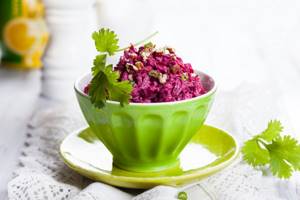
Pork with feijoa
This delicious meat salad is easy and simple to prepare; even novice cooks can handle this recipe.
List of ingredients:
- pork pulp - 300 g;
- exotic berry - 150 g;
- lime - half;
- almonds - 30 g;
- flour - 2 tablespoons;
- onion - one turnip;
- vegetable oil;
- soy sauce.
Feijoas go well with meat products; such dishes will diversify your daily diet.
Cooking method:
- Wash the pork, dry it with a paper towel and cut into thin slices.
- Dip them in flour and fry in well-heated vegetable oil for 5 minutes.
- Cut the lime and berries into slices, finely chop the onion and add to the meat, cook for another 3 minutes.
- Remove from heat and season with soy sauce.
- Pour boiling water over the almonds and leave for 10 minutes.
- Place it in a bowl of cold water.
- After five minutes, remove the peel from the nuts; it will come off well.
- Cut them into thin slices and use to decorate the dish.
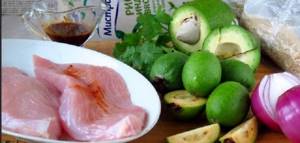
Tincture
Ripe feijoa tastes like a mix of kiwi, pineapple and strawberries. These notes manifest themselves well in alcohol, so a pleasant tincture is prepared from such fruits at home. If desired, you can enrich the taste by adding fresh cranberries to the drink.
To make alcohol, it is important to use ripe or overripe berries without rot or spoilage. Only a high-quality base is suitable for infusion, for example, highly purified moonshine, luxury vodka or ethyl alcohol diluted with clean water.
Components:
- feijoa - 300 g;
- alcohol - half a liter;
- cranberries - 100 g;
- sweetener (sugar or honey) - 100–150 g.
Cranberries will add tartness and interesting sourness to the product. Instead, you can take strawberries, strawberries or Victoria - this option will appeal to the fair sex. You shouldn’t mix the berries; if you want to try everything, it’s better to make three different tinctures.
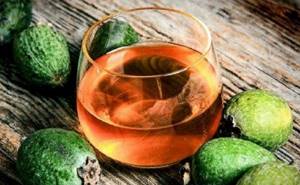
Recipe:
- Rinse the feijoa well in warm water and, without peeling, cut into small pieces.
- Grind the cranberries in a blender until a liquid and homogeneous mass is obtained.
- Place the prepared ingredients in a container for infusion, add sugar and pour vodka.
- Close the lid tightly and place in a dark place for 14 days. Shake the jar thoroughly once a day.
- Strain the finished tincture through a piece of gauze, squeeze the cake well.
- Taste the drink; if necessary, add sugar or dilute with water to reduce the strength.
- Pour into glass bottles and seal carefully. Over time, the tincture may become cloudy; this will not affect the taste, but you can additionally filter it through cotton wool.
This drink can be stored away from direct sunlight for up to 12 months.

Growing at home
Many lovers of indoor plants are thinking about growing feijoa at home. This will allow you to get delicious fruits directly from the bush, as well as admire the beautiful flowering.
Rules for caring for a tree:
- In the summer, the tropical plant can be placed on an open balcony or terrace; it can easily tolerate 30 degree heat, although experts recommend keeping it cool (20-22°C). In winter, the bush goes into hibernation, so it needs to be moved to a room with a temperature of 10–14 degrees. It is worth remembering that the flower does not like direct sunlight, as it can burn its crown.
- On dry and hot days, it is necessary to spray the feijoa foliage and the soil in which it grows. Watering is carried out after the earthen ball dries out by ¼, since the bush loves moisture very much.
- Feijoa loves frequent feeding; for this, it is fertilized every two weeks with nitrogen-based liquid formulations.
- The plant needs a certain soil; it is prepared from turf, leaf soil, peat, humus and river sand. All components are taken in equal proportions and calcined in a frying pan with a thick bottom.
- If you plan to grow the tree for the purpose of producing berries, it is important to remember that feijoa flowers are cross-pollinated, so it is worth having at least two bushes. However, self-pollinating hybrids have been bred, these include Crimean early and Nikitsky aromatic.

Health Benefits
Supports the Digestive System

Feijoa is a good source of soluble fiber. And dietary fiber can stimulate intestinal motility and increase the secretion of gastric juice, which facilitates the digestion process and prevents constipation and flatulence. In addition, fiber can bind and remove carcinogens from the intestines, thereby preventing the development of colorectal cancer. Vitamin B6 makes this fruit an effective remedy against nausea and vomiting.
Does not increase blood sugar levels
People with type 2 diabetes can consume this fruit without any worries as it belongs to the low glycemic index food category. This means that as it breaks down in the body, it is slowly absorbed into the blood, preventing sudden changes in glucose levels in the bloodstream.
Stabilizes blood pressure
The benefits of feijoa include the ability to prevent high blood pressure. Rich in potassium and low in sodium helps relax blood vessels and ensure proper blood pressure in the body.
Reduces the risk of developing cardiac diseases
Fiber, ascorbic acid, vitamin B6 and potassium are known to be beneficial for maintaining heart health. The named substances are contained in sufficient quantities in feijoa fruits. In addition, it is important to remember that these fruits cleanse the body of excess cholesterol, which is also important for a healthy heart.
Helps fight infections
100 g of feijoa pulp contains approximately 82 percent of the recommended daily intake of vitamin C. And it is known to be a powerful natural antioxidant that helps the body resist infections and viral diseases. In addition, it has anti-carcinogenic properties, protects against free radicals, and effectively strengthens the immune system.
Antioxidant fruit
Ripe fruits contain manganese, which is an important cofactor for several enzymes necessary for energy production and the formation of antioxidant defenses. This means that some enzymes need manganese to neutralize free radicals, and feijoa fruits will help replenish its reserves.
A study conducted by American scientists showed that people who regularly consume this fruit have an almost 50 percent lower risk of dying from coronary heart disease.
Improves memory, attention and concentration
Several components of the fruit, including potassium, folic acid and various antioxidant substances, provide neurological benefits to the body. Folic acid, for example, reduces the risk of Alzheimer's disease and prevents cognitive disorders, protects against the development of dementia. Potassium is known to stimulate blood flow to the brain, activating neurons that improve concentration and cognitive abilities. And thanks to vitamin B6, feijoa will protect against depression. Researchers say that two servings of these exotic fruits per day will minimize the risk of developing depression, anxiety levels and the effects of stress.
Useful during pregnancy

Feijoa fruits are rich in iron and folic acid, which are critical for the formation of blood cells. Both substances are simply irreplaceable for expectant mothers. Iron will prevent anemia, and folic acid will protect the child from developmental pathologies. On the other hand, fruit pulp rich in fiber will improve intestinal function, which is a “weak spot” for many pregnant women. It should also be remembered that feijoa, more than other fruits, is rich in iodine, and it is an indispensable element for the body of the expectant mother.
Feijoa is perhaps one of the most unexpected sources of iodine
Source of iodine
This mineral deserves to be discussed separately. Many are accustomed to replenishing their iodine reserves from seafood, but this fruit is also beneficial for those with iodine deficiency. Feijoa should appear in the diet of people suffering from goiter or hypothyroidism. Regular consumption of the fruit will prevent obesity, improve metabolism, reduce sensitivity to cold, and relieve fatigue and depression, which are signs of thyroid dysfunction.
Other beneficial properties of feijoa fruits:
- prevent chronic colds;
- improve the functioning of the nervous system;
- strengthen gums;
- prevent anemia;
- strengthen bones;
- accelerate the body’s recovery after injuries and illnesses;
- improve lung health;
- protect against harmful bacteria;
- activate the thyroid gland;
- accelerates wound healing;
- help fight chronic weakness.
general description
The small genus Feijoa is a representative of the Myrtaceae family. It includes shrubs of three varieties, but only one of them is cultivated - Feijoa Sello.
A tree-like plant (shrub) can reach 4 meters in height. Its branches are covered with hard, oval-shaped leaves that retain their bright color throughout the year. The upper part of the leaf plate is painted green, the lower part is silver-gray. The trunk is covered with rough brown bark, and the branched root system actively grows in the top layer of soil, covering large areas so that the moisture-loving plant always has access to water.
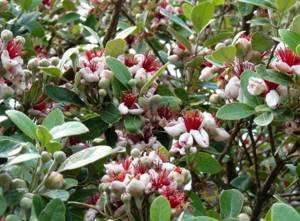
The bushes become especially attractive during the flowering period. In May-June they are covered with bisexual flowers, the diameter of which is no more than 4 cm. Their petals are fleshy, edible, and have a sweetish taste. The color of the petals is white with pinkish splashes, and inside there are numerous long stamens of a purple hue. The buds grow singly on young branches or form lush inflorescences that delight the eye until the beginning of July.
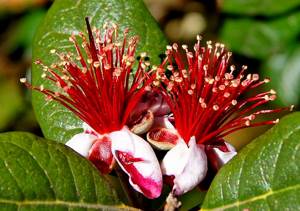
Where does it grow
Civilized people became acquainted with feijoa not very long ago. The German botanist Friedrich Sello encountered this shrub in the middle of the last century when he was exploring the tropical forests of South America. The specific name feijoa was given by the name of the discoverer Sello. The shrub received its generic name in the 19th century after the director of the Brazilian Museum of Natural History, Johnny de Silva Feijo.
The bushes were brought to Europe in 1890, and 23 years later they ended up in the botanical gardens of Italy. From there, the plant spread throughout the Mediterranean countries, after which it reached the southern lands of East Asia.
Feijoa can take root in any region where winter frosts do not fall below -12 ° C, and the summer is hot. Thailand and South America are considered the homeland of this tropical beauty: Brazil, northern Argentina, Paraguay, Uruguay.
Today, feijoa is grown for harvest in the following countries:
- New Zealand;
- Turkmenistan;
- Australia;
- Vietnam;
- Italy;
- Russia (Crimea, Krasnodar region);
- Argentina;
- Cambodia;
- Indonesia;
- Chile;
- Singapore;
- Panama;
- Uruguay;
- Georgia;
- Laos;
- Malaysia;
- Azerbaijan;
- Brazil;
- Ukraine.
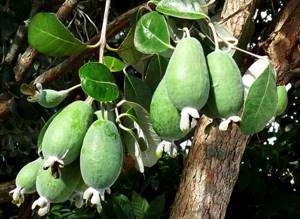
Where can I buy
Feijoa, whose benefits have been proven three hundred years ago, grows in tropical and subtropical climates. Shrubs cannot withstand temperatures below -11 degrees. Since the beginning of the nineteenth century, feijoa has been successfully bred on the Black Sea coast.
You can buy fresh feijoa during the season: from mid-summer to early winter. In the Krasnodar Territory, Crimea and Abkhazia, harvesting occurs in August-September. Feijoas exported from other continents are sold in chain stores aimed at buyers with above-average incomes. When choosing a product you need to be especially careful. The ripeness of the berries is determined by the color of the pulp. White pulp indicates that the berries are not yet ripe. They can be purchased, but left to ripen for some time in a warm, well-ventilated area. But berries with brown pulp indicate that the product is overripe and decomposition processes are occurring in it. Eating such berries is dangerous.
You can also find compotes, preserves and jams made from feijoa on sale. Canned products are relevant at any time of the year. When properly prepared, the product retains the beneficial properties of feijoa.
You should also not forget about the basics of proper nutrition, otherwise proper preparation of the fruit will not help one hundred percent. You can read more about healthy nutrition on the Internet. For example, on this page you have the opportunity to familiarize yourself with information about proper balanced nutrition https://slavklin.ru/ or on another resource of your choice.
Basic rules of use
Only ripe feijoas can be consumed raw; unripe feijoas can cause poisoning. The berries can be eaten raw or added to baked goods, fruit salads, cocktails, or made into jam. It should be remembered that during heat treatment, beneficial substances are minimized, and the taste loses its freshness and juiciness.
In order for the healing properties to have a positive effect on the body, feijoa must be consumed regularly - at least a month, but no more than 1-2 pieces per day. 4-5 fruits in one day will cause an overdose of iodine in an adult, which is manifested by increased blood pressure, elevated temperature, excessive excitability, anxiety, and a metallic odor in the mouth.
For the salad, finely chop the apple, tangerine and feijoa. The ingredients are mixed with raisins and seasoned with heavy cream, sour cream or natural yogurt. You can add nuts and vanilla sugar.
